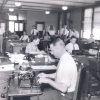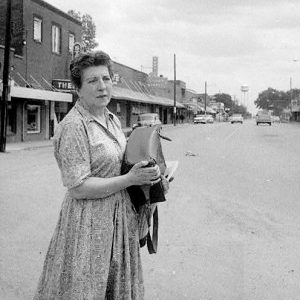calsfoundation@cals.org
Esther Bindursky (1905–1971)
Esther Bindursky, editor of the weekly Lepanto News Record for thirty-four years, was an award-winning journalist and photographer known for her perceptive feature and column writing, newsworthy pictures, and selfless community service.
Esther Bindursky was born on January 28, 1904, in Drew, Mississippi. Her father, Meyer Bindursky, born in Bessarabia (which was divided between Moldova and Ukraine after the collapse of the Soviet Union), was a merchant, and her mother, Minnie Iskiwitch, a native of Poland, was a homemaker. Bindursky had three brothers.
Shortly after her graduation from high school in 1922, she moved with her parents to Lepanto (Poinsett County). As a young woman, she played the piano for silent movies in the Lepanto movie theater. When the devastating Flood of 1927 struck the east Arkansas Delta, she became secretary of the Poinsett County American Red Cross chapter and then became a caseworker for the Arkansas Emergency Relief Commission.
In her role as a flood relief worker, she supplied information to the Memphis, Tennessee, Commercial Appeal, which served as a daily newspaper for east Arkansas. In the early 1930s, she became a correspondent for that paper, reporting from her home in Lepanto. She began with reports of natural disasters, highway fatalities, violent crimes, and obituaries and later progressed to feature stories carrying her byline. In 1937, Guy Graves, who was publishing two weekly papers in Poinsett County, established the weekly Lepanto News Record and asked Bindursky to be its editor.
From 1937 until her death in 1971, Bindursky was the only staff member of the paper. She wrote all the news, features, society stories, and obituaries. She designed and sold ads, took pictures, and wrote a column titled “This One’s On Me,” with the frequent subtitle, “Draggin’ Main.” She often assumed the duties of printer in making up pages.
She was a charter member of the Arkansas Newspaper Women when it was founded in 1949 and was its president in 1950. This organization was a precursor to the Arkansas Press Women.
Her mastery was evident in the first-place awards she received from national and state press organizations. These included a National Editorial Association award for community service; awards from the National Federation of Press Women (NFPW) for photography, advertising, and feature writing; and awards from the Arkansas Press Association and Arkansas Newspaper Women for column and feature writing, general excellence, typography, photography, and community service. This recognition led to Bindursky being invited to be the featured weekly editor at the University of Missouri’s Journalism Week in 1956.
In addition to reporting on local events, she wrote features for the Commercial Appeal and the Arkansas Gazette. In 1937, the national Literary Digest magazine gave a full page to her coverage of Lepanto’s annual fall event, the Terrapin Derby. Her story about a young Lepanto man, Staff Sergeant Jimmy Hendrix, who received the Medal of Honor, ran as a feature in the October 20, 1945, issue of the Saturday Evening Post.
She was also a skilled photographer. One of her nationally circulated news photos of a nun who survived a 1955 train wreck in Marked Tree (Poinsett County) that killed five people won a first-place National Federation of Press Women award and was nominated for a Pulitzer Prize.
Bindursky used vacation time to attend national editorial and press organization meetings, and she developed a nationwide circle of friends and admirers. In 1960, the National Editorial Association invited her to be among the first group of American journalists to visit eight European countries, including the Soviet Union. When Lepanto civic leaders learned of the invitation, they secretly raised the tour cost, $1,575, and surprised her with it at the annual Chamber of Commerce dinner, at which she was named Woman of the Year.
During the delegation’s visit to Russia, she had her picture taken in front of a golden door at the Palace of the Czars and said of it, “My father, who once had to serve in Czar Nicholas’s Army… would have gotten a bang out of that solid gold door. Strange, the Russians, who abhor money as a dirty, capitalistic menace, should guard and treasure this memento of the past.”
Bindursky died of lung cancer in Memphis on April 23, 1971. Her death was reported in a three-paragraph obituary in the April 25, 1971, issue of The New York Times. She is buried in the Temple Israel Cemetery in Memphis, a Jewish cemetery. She had never married and had no children.
For additional information:
Jernigan, Gail, and Sue Chambers. A History of Lepanto. Lepanto, AR: Museum of Lepanto, 1989.
Kenny, Catherine. “Draggin’ Main with Esther Bindursky.” Arkansas Times 13 (March 1985): 40–43, 71–72.
Dorothy D. Stuck
Hot Springs, Arkansas
This entry, originally published in Arkansas Biography: A Collection of Notable Lives, appears in the CALS Encyclopedia of Arkansas in an altered form. Arkansas Biography is available from the University of Arkansas Press.
 Mass Media
Mass Media World War II through the Faubus Era, 1941 through 1967
World War II through the Faubus Era, 1941 through 1967 Esther Bindursky
Esther Bindursky 




Comments
No comments on this entry yet.